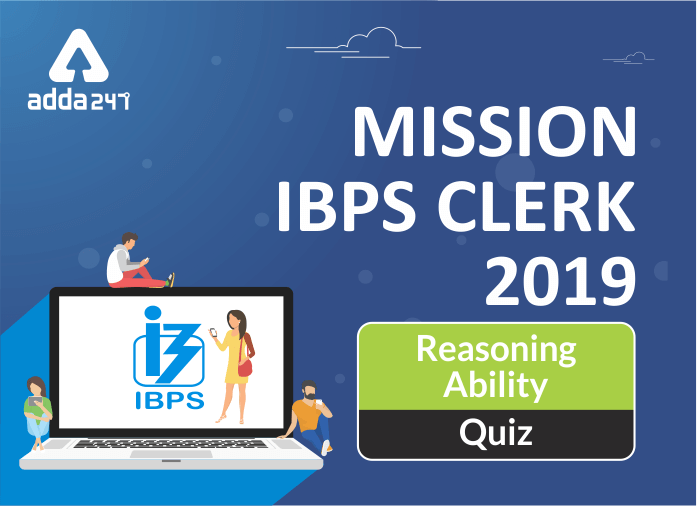The reasoning being the scoring part can enhance your performance as a whole. All you need to do is clear your basics and be aware of the syllabus of the particular exam you are preparing for. Giving mocks and Quizzes on a regular basis will help you to decode the strategy. Also, the Study Plans go hand in hand with the exam preparations that will take place in the upcoming months. Like the IBPS Clerk Prelims are scheduled in the month of December and we already rolled the study plan for IBPS Clerk. Under the same plan, here is the Quiz for Reasoning, to make sure that you don’t skip any important topic as well as be prepared to face any type of questions in the prelims. IBPS Clerk Reasoning Quiz of 13th October 2019 covers Miscellaneous Topic.
Directions (1-5): Study the information carefully and answer the questions given below.
Seven persons are sitting in a linear row. All of them are facing south. Equal number of persons sits to left and right of X. Two persons sit between X and C. D sits second to the right of B. More than three persons sit between A and Y, who doesn’t sit at extreme end of row. Z is not immediate neighbor of B.
Q1. Who among the following person sits fourth to the right of Z?
(a) A
(b) X
(c) B
(d)D
(e) None of these
Q2. Who among the following is immediate left of D?
(a) Z
(b) B
(c) X
(d) A
(e) None of these
Q3. How many persons sit between Y and B?
(a) Three
(b) Four
(c) one
(d) Two
(e) None
Q4. Four of the following five are alike in certain way based from a group, find the one that does not belong to that group?
(a) X-Z
(b) B-D
(c) Y-X
(d)A-Z
(e) B-C
Q5.If A and D change there places then which of the following person sit immediate right of A?
(a) Y
(b) B
(c) Z
(d) C
(e) None of these
Solutions (1-5):

S1.Ans(e)
S2.Ans(c)
S3.Ans(e)
S4.Ans(d)
S5.Ans(c)
Directions (6-10): In these questions, a relationship between different elements is shown in the statements. The statements are followed by two conclusions. Give answer
Q6. Statement: A>B; G<D≤E; G≥F>B
Conclusion: I. G≥A II. B<E
(a) if only conclusion II is true.
(b) if only conclusion I is true.
(c) if neither conclusion I nor II is true.
(d) if either conclusion I or II is true.
(e) if both conclusions I and II are true.
S6. Ans.(a)
Sol. I. G≥A(False) II. B<E(True)
Q7. Statement: A>T≥J; A≤S=H; I>T
Conclusion: I. H>J II. I>S
(a) if both conclusion I and II are true.
(b) if only conclusion I is true.
(c) if neither conclusion I nor II is true.
(d) if either conclusion I or II is true.
(e) if only conclusion II is true.
S7. Ans.(b)
Sol. I. H>J(True) II. I>S (False)
Q8. Statement: J≥K>L<M≥N; K≥O=T
Conclusion: I. J>O II. J=T
(a) if only conclusion II is true.
(b) if either conclusion I or II is true.
(c) if neither conclusion I nor II is true.
(d) if only conclusion I is true.
(e) if both conclusions I and II are true.
S8. Ans.(b)
Sol. I. J>O(False) II. J=T (False)
Q9. Statement: A> T=N; A>S>R; A<M
Conclusion: I. R<T II. N≤R
(a) if only conclusion II is true.
(b) if only conclusion I is true.
(c) if neither conclusion I nor II is true.
(d) if either conclusion I or II is true.
(e) if both conclusions I and II are true.
S9. Ans.(d)
Sol. I.R<T(False) II. N≤R(False)
Q10. Statement: A<B≤C; F<M≤C; C>Q
Conclusion: I. Q≤F II. F>Q
(a) if only conclusion II is true.
(b) if either conclusion I or II is true.
(c) if neither conclusion I nor II is true.
(d) if only conclusion I is true.
(e) if both conclusions I and II are true.
S10. Ans.(c)
Sol. I. Q≤F (False) II. F>Q(False)
Directions (11-15): The following questions are based on the five three digits numbers given below:
583 659 427 361 416
Q11. If in each number, all the three digits are arranged in ascending order within the number, which of the following will be the fourth lowest number?
(a) 583
(b) 659
(c) 427
(d) 361
(e) 416
S11. Ans.(a)
Sol. After arranging all the digits in ascending order within each number–
358 569 247 136 146
So, the fourth lowest number will be 583.
Q12. If first digit will be changed (replace) with third digit, then second with first digit and after that third digit with the second digit in each number, then which number will be the lowest?
(a) 583
(b) 659
(c) 427
(d) 361
(e) 416
S12. Ans.(e)
Q13. If the position of first and third digits of the numbers are interchanged with each number then how many numbers thus formed will be completely divisible by 2?
(a) None
(b) Three
(c) More than three
(d) One
(e) Two
S13. Ans.(b)
Sol. After interchanging first and third digits according to the given condition in the question—
385 956 724 163 614
So number completely divisible by 2 will be three.
Q14. What will be result if first digit of second highest number is divided by second digit of second lowest number?
(a) 4
(b) 5
(c) 7
(d) 2
(e) 1
S14. Ans.(b)
Sol. First digit of second highest number is 5 and second digit of the second lowest number is 1. So, the resultant will be 5.
Q15. If in each number, both first and second digits are added and then third digit will be subtracted from that addition then which of the following will be the highest resultant?
(a) 4
(b) 2
(c) 1
(d) 8
(e) 10
S15. Ans.(e)
If you are preparing for IBPS Clerk Exam, then you can also check out a video for Reasoning below:
You may also like to Read:




 GA Capsule for SBI Clerk Mains 2025, Dow...
GA Capsule for SBI Clerk Mains 2025, Dow...
 The Hindu Review October 2022: Download ...
The Hindu Review October 2022: Download ...
 IB ACIO 2025 Notification PDF Out for 37...
IB ACIO 2025 Notification PDF Out for 37...


